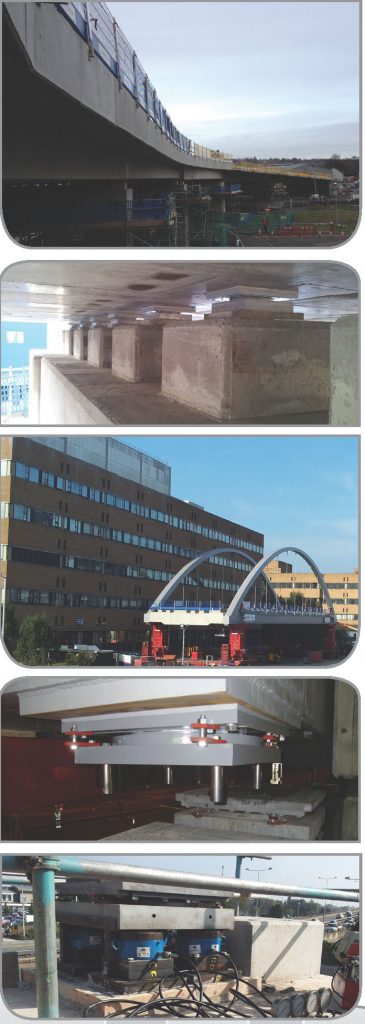Client
Taylor Woodrow / ALSTOM Joint Venture
Consultants
Mott MacDonald
Value
£720,000
Works Commenced
July 2013
Works Completed
March 2014
The QMC Viaduct carries a tramway over the A52 Clifton Boulevard and through the grounds of the Queen’s Medical Centre in Nottingham.
In July 2013 Freyssinet was appointed by Taylor Woodrow to undertake the following viaduct refurbishment works:
- Design of a safe and economical temporary work system to land 22m long prestressed, precast beams, weighing up to 40tonne safely onto insitu abutments and piers, stretching over a length of 400m
- Installation of around 150tonne of temporary steelwork and temporary bearings
- Installation of temporary bracing system during placement of the precast beams
- Design and installation of jacking system, jacking the deck to remove temporary works
- Installation of permanent bearings
- Dejacking of bridge decks upon completion
- Welding of taper plates and bearing top plates followed by weld test procedures
- Approval testing of cementious grout materials
- Site trials on placing methods of the grout products
- Concrete repairs
- Corrosion protection to permanent works
Freyssinet introduced an alternative method of temporary support, installing temporary support steelwork directly onto the piers and abutments. This innovative method proved to be quick and efficient, saving time in comparison with the traditional method of propping off the foundation. Freyssinet also had to incorporate requirements of the formwork and falsework which the framework contractor needed to construct the end diaphrams and bridge decks.
During the design of the temporary works, Freyssinet encountered a few challenges that needed to be overcome. This included the different inclines, cambers and overall curvature of the structure, followed by the beam articulation in the temporary placing stages, the jacking stages and the permanent stage. The most challenging issue was stopping the beams from sliding on the steep inclines – a unique stop angle bracket system was developed to solve this.
In addition, Freyssinet undertook the following works in regard to the A52 steel bridge:
- Design and installation of a temporary support system
- Design and Installation of temporary bearings
- Design and installation of the jacking system
- Installation and grouting of permanent bearings
Freyssinet developed a concept to enable the placing of the A52 steel bridge on temporary supports. The 1060Tonne Bowarch Bridge was constructed on site before being transported to its final destination. 800Tonne temporary bearings were installed on pairs of jacks supported by jacking plates and grout plinths. The permanent bearings were installed to the A52 steel bridge by securing the top plate to the underside of the A52 main girder, allowing the bearing to hang into position.
Once the bridge was positioned, the bridge was jacked off the temporary bearings to the correct height and the permanent bearings were grouted followed by dejacking once cured.

